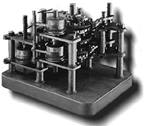 |
||
 |
||
Gallery
|
 Forerunner of computer, difference engine by Charles Babbage begun in 1823 |
 Samuel Morse's painting of Lafayette, 1826 |
|
|
 Earliest Niépce camera 1826 |

Copyright © Irving Fang and Kristina Ross, 1995-1996. All rights reserved.